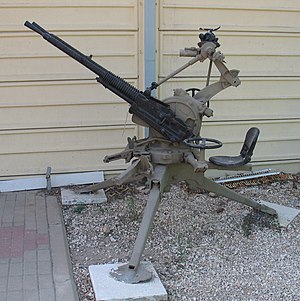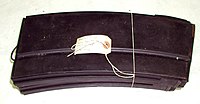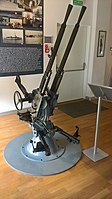Hotchkiss 13.2 mm machine gun
| Hotchkiss 13.2 mm machine gun Mitrailleuse Hotchkiss de 13,2 mm | |
|---|---|
 A mitrailleuse de 13.2 mm CA mle 1930 in Batey ha-Osef Museum, Tel Aviv, Israel. | |
| Type | Heavy machine gun |
| Place of origin | France |
| Service history | |
| Used by | See Users |
| Wars | World War II |
| Production history | |
| Designed | 1929 |
| Manufacturer | Hotchkiss et Cie |
| Specifications | |
| Mass | 37.5 kg (83 lbs) single gun, stripped |
| Length | 1.67 m (5 ft 6 in) |
| Barrel length | 1 m (3 ft 3 in) |
| Shell |
|
| Caliber | 13.2 mm |
| Action | Gas operated |
| Elevation | -10° to +90° |
| Traverse | 360° |
| Rate of fire | 450 rpm (cyclic) 200-250 rpm (sustained) |
| Muzzle velocity | 800 m/s (2,625 ft/s) |
| Effective firing range | 4,200 m (13,800 ft) AA ceiling |
| Maximum firing range | 7.2 km (4.5 mi) at 45°[1] |
| Feed system | 30-round box magazine, or 15-round feed strip |

The Hotchkiss 13.2 mm machine gun (French: Mitrailleuse Hotchkiss de 13,2 mm), also known as the Hotchkiss M1929 machine gun (Mle 1929, Mle 1930, etc), was a heavy machine gun, primarily intended for anti-aircraft use, designed and manufactured by French arms manufacturer Hotchkiss et Cie from the late 1920s until World War II, which saw service with various nations' forces, including Italy and Japan where the gun was built under license.[2]
Development[edit]
In the 1920s, Hotchkiss developed a range of anti-aircraft automatic weapons in the 13.2, 25 and 37 mm calibers. They were all based on the same type of gas-operated action, similar to the one used in the 8 mm Hotchkiss Mle 1914 machine gun, which had proven extremely reliable during World War I and was still in service.
The 13.2 mm machine gun project was started in 1922 as an aircraft machine gun, but the French government classified the belt-fed version (while not funding its further development), and only the magazine version (only useful for ground and naval use) was allowed to be exported, starting from around 1927.[3]
Performance[edit]
The Hotchkiss M1929 machine gun had a cyclic rate of fire of 450 rounds per minute, but their practical sustained rate of fire was just 200-250 rounds per minute due to limited magazine capacity. The majority of Hotchkiss M1929 machine guns were fed by overhead, 30 round, curved box magazines. These magazines would run empty in 4 seconds, requiring frequent magazine changes which limited their rate of fire.
Cartridges[edit]
The Hotchkiss M1929 machine gun was initially chambered for the cartridge 13.2 × 99 mm Hotchkiss "Long", which essentially was a 12.7 × 99 mm Browning (.50 BMG) cartridge necked up to 13.2 mm caliber.[4] This cartridge however proved to wear out gun barrels too quickly and to alleviate this inconvenience Hotchkiss introduced a new cartridge for the M1929 machine gun in 1935, featuring a slightly shorter cartridge case and reworked projectile shape, becoming the cartridge 13.2 x 96 mm Hotchkiss "Short". The new cartridge was practically identical to the original 13.2 x 99 mm cartridge except for the length of the neck, reducing the full case length to 96 mm. This minimal change was done so that existing weapons and the production line did not require any modification to fire the new cartridge, but was sufficient to fix the barrel wear issue.
Configurations[edit]
The Hotchkiss M1929 machine gun came in a number of different configurations depending on their intended role. There were single, double and quadruple barreled anti-aircraft weapons on a high-angle pedestal and tripod mounts, as well as low-angle bipod mounts for anti-tank and heavy machine gun roles.
French infantry commanders, who had expressed interest in acquiring light anti-aircraft guns, refused to accept the 13.2 mm. They argued that the heavy bullets falling down could be dangerous to friendly troops, and preferred larger calibers for which self-destructing shells were available. But the 13.2 mm Hotchkiss saw extensive use as a naval gun and was also chosen by the French cavalry for some of its armored vehicles.
-
A Japanese 30 round box magazine
-
13.2 mm cartridges top to bottom:
13.2×99mm Hotchkiss Long
13.2×96mm Hotchkiss Short
13.2×92mmSR Mauser TuF -
A quadruple naval mounting, as illustrated in US Patent 1700902 filed by Yves Le Prieur
Service[edit]
As a ground-based anti-aircraft weapon[edit]
The French Air Force used the M1929, designated as mitrailleuse de 13.2 mm CA mle 1930, for close-range defense of its airfields and other strategic places.
It came in two versions:
- A single gun with a stock and pistol grip that came in a dual-purpose anti-aircraft/anti-armor mounting. It had a two-wheeled split-trailed carriage that weighed 117 kg (259 lb) empty and 155 kg (342 lb) with the machine-gun mounted. When the swing-arm the gun was affixed to was locked upwards, it could be used in an anti-aircraft mode. When the arm was collapsed and a bipod extended it could fire straight ahead in an anti-tank role. When the gun was packed up and the trails closed, it was towed behind its caisson, which was pulled by a horse or by the gunner.
- A fixed tripod mount with a seat and anti-aircraft sight for the gunner. This came in single or twin mounts. The single mount weighted 120 kg (270 lb) empty, 160 kg (352 lb) mounted. The double mount weighed 225 kg (496 lb) empty, 300 kg (662 lb) mounted.
[edit]
Early in World War II, the French, Italian and Japanese navies were using twin (CAD Mle 1929 - Contre Avions Double) and quadruple (CAQ mle 1929 - Contre Avions Quadruple) mountings on many of their warships. French warships that were refitted in the United States in 1943, such as the battleship Richelieu or the destroyer Le Terrible, had their 13.2 mm machine guns replaced by more powerful Oerlikon 20 mm cannons.
In Italy, the Società Italiana Ernesto Breda produced the gun under license as the Breda Mod.31 from 1931 onwards. It was used as an anti-aircraft gun aboard ships, submarines, and armored trains of the Royal Italian Navy. After World War II it was used on the patrol boats of the Guardia di Finanza.
The Spanish Navy bought the weapon in December 1935 and used it during the Civil War (where it was mounted on several Republican Navy destroyers and cruisers). The "Pirotecnia Militar" Army Ammunition plant (Sevilla) produced its cartridges after 1939.
As a ground weapon[edit]
Several self-propelled anti-aircraft combinations were tested in the 1930s, with Citroën-Kegresse or Berliet chassis, but none was mass-produced. The 13.2 mm Hotchkiss was used on the Belgian T15 and the French AMR 35 light tanks as well as on the White-Laffly AMD 80 armoured car and on fortifications. The Free French used field-modified self-propelled mountings, with guns recovered from French ships, in North-East Africa in 1942. The Breda Mod.31 was used as an anti-aircraft and heavy machine gun on command tanks of the Royal Italian Army as well as on L3/33 light tanks sold to Brazil. The Japanese mounted license-produced version of the gun on a number of Type 92 Heavy armored Cars which had initially been armed with only a pair of 6.5 mm machine guns.[5]
Users[edit]
This article needs additional citations for verification. (May 2020) |
 Belgium
Belgium Brazil
Brazil France
France Nazi Germany - Captured French guns were designated MG 271(f).
Nazi Germany - Captured French guns were designated MG 271(f). Greece - Some modified for larger magazine capacities and closed-bolt operation
Greece - Some modified for larger magazine capacities and closed-bolt operation Israel
Israel Italy - Built under license as the Breda Model 1931 machine gun.
Italy - Built under license as the Breda Model 1931 machine gun. Japan - Built under license as the Type 92 tank machine gun and Type 93 heavy machine gun.[5][6]
Japan - Built under license as the Type 92 tank machine gun and Type 93 heavy machine gun.[5][6] Poland - Designated the wz.30.
Poland - Designated the wz.30. Republic of China
Republic of China Romania - 200 delivered before the Fall of France[7] and delivered by Germans from captured material[citation needed]
Romania - 200 delivered before the Fall of France[7] and delivered by Germans from captured material[citation needed] Spain
Spain Sweden - License built Breda Model 1931 machine guns bought from Italy. Designated 13,2 mm kulspruta M/It (13,2 mm ksp M/It)[8]
Sweden - License built Breda Model 1931 machine guns bought from Italy. Designated 13,2 mm kulspruta M/It (13,2 mm ksp M/It)[8] Kingdom of Yugoslavia
Kingdom of Yugoslavia
Gallery[edit]
-
A wz.30 dual gun pedestal mount used on the Polish submarine ORP Żbik
-
Japanese Type 92 tank machine gun (foreground)
-
The related Japanese Type 93 single mount
-
The related Japanese Type 93 double mount
See also[edit]
- Anti-aircraft gun
- 25 mm Hotchkiss anti-aircraft gun - A closely related French anti-aircraft gun.
- Type 96 25 mm AT/AA Gun - A closely related Japanese anti-aircraft gun.
References[edit]
Footnotes[edit]
- ^ "France 13.2 mm (0.5") Model 1929 - NavWeaps". www.navweaps.com. Retrieved 2019-03-30.
- ^ "Modern Firearms". 27 October 2010.
- ^ "HyperWar: The Machine Gun (Vol. I/Part IV)". www.ibiblio.org. Retrieved 10 August 2023.
- ^ "13,2x96 Hotchkis Short / MUNICION.ORG". www.municion.org. Archived from the original on 2019-03-30. Retrieved 2019-03-30.
- ^ a b Zaloga, Steven J. (2007). Japanese Tanks 1939–45. Osprey. p. 7. ISBN 978-1-8460-3091-8.
- ^ Lai, Benjamin (29 Jun 2017). Shanghai and Nanjing 1937: Massacre on the Yangtze. Campaign 309. Osprey Publishing. p. 26. ISBN 9781472817495.
- ^ Mark Axworthy, London: Arms and Armour, 1995, Third Axis, Fourth Ally: Romanian Armed Forces in the European War, 1941–1945, p. 29
- ^ Amregister Fl, Ammunitionsregister för flottan, 1947 års upplaga. Stockholm: Ammunitionssektionen vid marinförvaltningens artilleribyrå. 1947.
Bibliography[edit]
- Campbell, John (1985). Naval Weapons of World War Two. Annapolis, Maryland: Naval Institute Press. ISBN 0-87021-459-4.
Further reading[edit]
- Ferrard, Stéphane. France 1940 l'armement terrestre, ETAI, 1998, ISBN 978-2-7268-8380-8
- "Las armas de la guerra civil española", José MAría MANRIQUE, ISBN 84-9734-475-8, pages 394 -398







